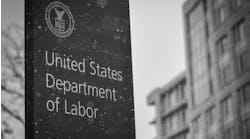In its final report on a liquid nitrogen release at the Foundation Food Group (FFG) facility in Gainesville, Ga., that fatally injured six workers on January 28, 2021, the U.S. Chemical Safety and Hazard Investigation Board (CSB) identified a number of equipment and process failures at the facility.
The FFG facility was a poultry processing operation that used liquid nitrogen to quickly freeze prepared poultry products. The CSB’s final report found that the liquid nitrogen release was caused by the failure of the liquid nitrogen control system in a freezer room due to a bent “bubbler tube.”
The bent tube allowed the room to fill with an unsafe level of liquid nitrogen that quickly vaporized into a four- to five-foot-high deadly cloud, resulting in the death of six employees by asphyxiation. Three other FFG employees and a firefighter who responded to the incident, were also seriously injured from asphyxiation.
The CSB’s report concluded that the bubbler tube likely was bent during maintenance in the freezer room. The report also determined that the severity of the incident was worsened by FFG’s inadequate emergency preparedness -- which resulted in at least 14 employees entering the freezer room or the surrounding area to investigate the incident or attempt to rescue coworkers -- and FFG’s failure to install air monitoring and alarm devices that could have alerted workers about the hazardous vapor cloud and warned them against entering the freezer room.
The freezer involved in the incident was designed and owned by Messer LLC, which leased it to FFG. After the incident, FFG sold the facility to Gold Creek Foods, which is the current owner of the facility. Gold Creek does not now have liquid nitrogen freezing processes in the building where the incident occurred.
The CSB’s final report emphasizes five key safety issues:
- Single Point of Failure: The immersion freezer design included a device called a bubbler tube, which was used to measure the liquid nitrogen level inside the freezer. The bubbler tube was likely bent during maintenance activity, rendering it unable to measure and control the freezer’s liquid nitrogen level. As a result, liquid nitrogen overflowed from the freezer and filled the room with vaporized nitrogen.
- Atmospheric Monitoring and Alarm Systems: There is abundant industry guidance on the importance of atmospheric monitoring when the potential for hazardous atmospheres exists. FFG, however, did not install atmospheric monitoring equipment in the freezer room.
- Emergency Preparedness: FFG did not inform, train, equip, drill, or otherwise prepare its workforce for a release of liquid nitrogen. FFG’s workforce lacked knowledge on the hazards of nitrogen, were unable to recognize an oxygen-deficient atmosphere, and lacked any equipment or Personal Protective Equipment (PPE) that would have enabled safe entry into an oxygen-deficient atmosphere.
- Process Safety Management System: FFG had no documented process safety management policy and allowed the job position responsible for safety management to be vacant for more than a year prior to the incident. The company did not evaluate the process hazards associated with the freezer, lacked written procedures and a management of change process, and did not train its workers on the asphyxiation hazards of liquid nitrogen.
- Product Stewardship: Messer owned the liquid nitrogen bulk storage tanks and the Line 4 immersion-spiral freezer and leased the equipment to FFG. At the time of the incident, Messer had institutional knowledge, experience, policies, and practices for effective product stewardship but applied those practices only to the bulk storage tanks and not to the Line 4 freezer process. Throughout its relationship with FFG, Messer identified issues with FFG’s safety practices and nonconformance to industry guidance, but despite FFG’s unsafe practices Messer continued to supply FFG with liquid nitrogen.
Other CSB’s safety recommendations were directed toward other entities, including the current facility owner, the manufacturer of the freezer, the Occupational Safety and Health Administration (OSHA), an industry trade association and two standard-setting organizations.


